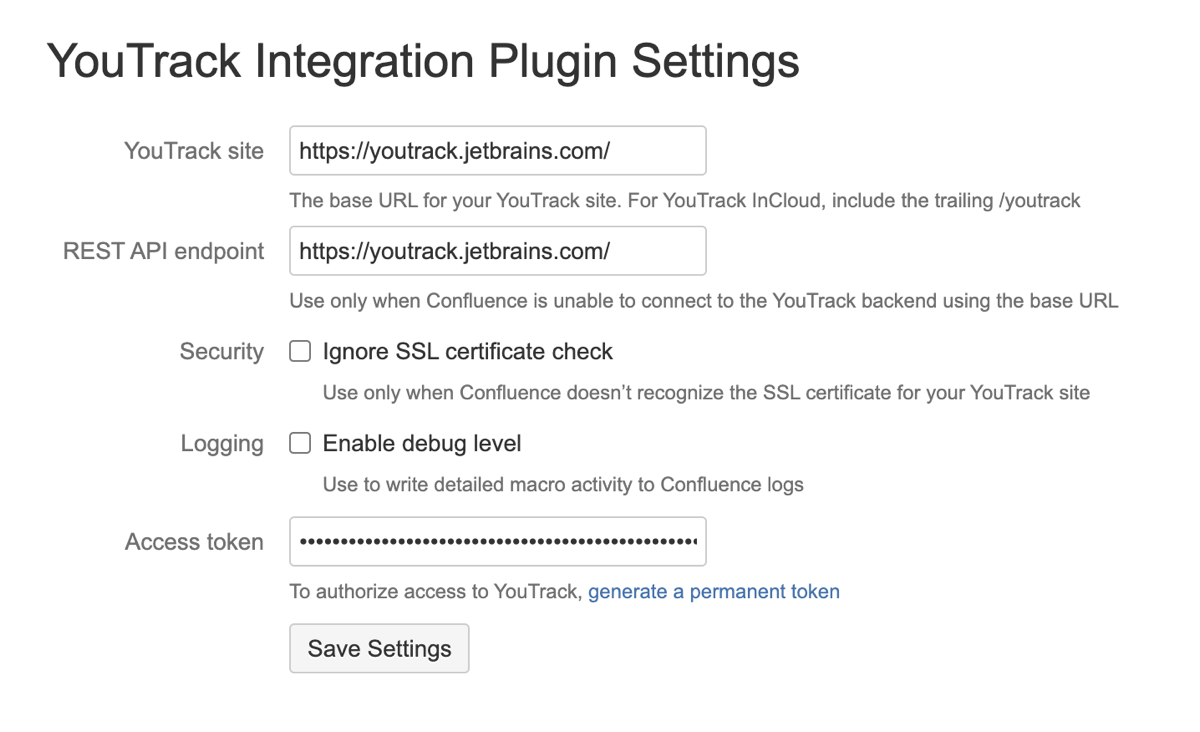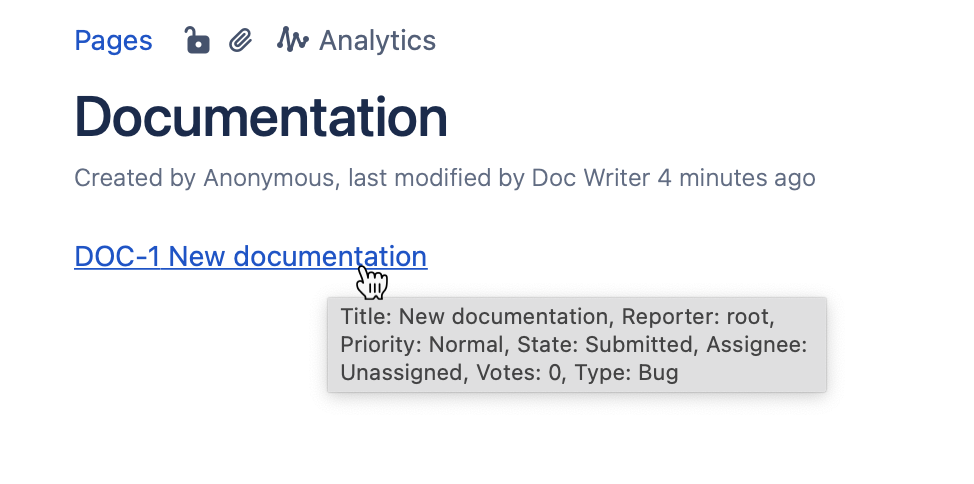Confluence Integration
This integration adds the following macros to your Confluence installation:
| Macro | Description |
|---|---|
| Issue | Inserts a link to a YouTrack issue into a page in Confluence. The link reflects the issue state. |
| Issue List | Lets you insert a list of YouTrack issues that match a query to a page in Confluence. |
Install and Configure the Add-on
The YouTrack Integration add-on enables the integration features in your Confluence installation.
For additional information, refer to the documentation for the Atlassian Universal Plugin Manager.
To install the add-on:
Next, configure the settings for the add-on.
To configure the add-on:
Open the Manage add-ons page, then select the YouTrack Integration add-on.
Click the Configure button.
The YouTrack Integration Plugin Settings page opens.

Enter values for the following settings:
Setting Description YouTrack site Enter the base URL for your YouTrack installation.
For YouTrack InCloud instances, your base URL includes the trailing
/youtrack. For example:https://yourcompany.myjetbrains.com/youtrack/rest/REST API endpoint Enter a URI that points to the REST endpoint for your YouTrack installation.
Use only when your Confluence site is unable to connect to the YouTrack backend using the base URL.
Ignore SSL certificate check When enabled, Confluence does not check for the SSL certificate for your YouTrack server when it tries to establish a connection.
Use only when your YouTrack SSL certificate is not recognized by your Confluence instance.
Enable debug level When enabled, the macros that are supported by the add-on write detailed information to Confluence logs. Access token Enter a permanent token that grants authorized access to your YouTrack site. The permanent token authorizes the add-on on behalf of the user that generates the token. To learn how to generate a permanent token for your account, see Create a Permanent Token.
Confluence users are only able to add links, reports, and create issues in projects that are accessible to this user. For best results, use an account that has a high level of access in YouTrack.
Click the Save Settings button.
The add-on is ready for use.
Insert a Dynamic Link to an Issue
To insert a dynamic link into a Confluence page, use the Issue macro with the following format: {issue:id=<issueID>}. The visual presentation of the link reflects the status of the issue.
Links to unresolved issues are shown in normal text.
Links to resolved issues are shown with strikethrough text.
Use the following settings to define the issue link:
| Setting | Description |
|---|---|
| Issue ID | Stores the ID of the issue in YouTrack. |
| Style | Determines the presentation of the issue link.
With either presentation style, the issue ID shows values for key custom fields and issue attributes in a tooltip. |
| Resolved issue presentation | Determines the presentation for issue links when the issue is resolved.
|
| Template | Stores a string of text that is shown for each issue link. The template supports a collection of placeholders for various issue attributes. These placeholders are replaced by the respective value for each issue when shown on the Confluence page. For example, if you enter the following string into the Template field: $issue $State fix before $Due_DateThe link for a specific issue would look like this:  The following placeholders are supported:
|
The following example shows a link to an unresolved issue:

When you move the pointer over this link, a tooltip displays additional information. This includes the issue summary, reporter, priority, state, assignee, votes, and type.
Use these links to aggregate a collection of issues that are related to the content on your Confluence pages.
Insert a List of Issues
To insert a list of issues that match a query in YouTrack, use the Report macro in the following format: {report:project=<projectID>|query=<search query>}
Use the following settings to define the report:
| Setting | Description |
|---|---|
| Project ID | Limits issues in the report to a single project. Enter the project ID. |
| Query | Specifies which issues are shown in the report. |
| Issue fields | Determines which fields and issue attributes are shown as columns in the table. |
| Issues per page | Determines how many issues are listed on a single page in the report. |
| Max pages | Sets the number pages that you can click through in the report. |
The following example shows a list of unresolved issues from the DOC project: {report:project=DOC|query=#Unresolved}

